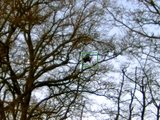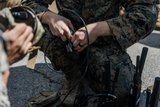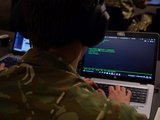Harris Corporation wins USMC radio order
Harris Corporation has announced that it has received orders worth a total of $64 million from the US Marine Corps (USMC) for its Falcon III AN/PRC-117G multiband manpack radios, vehicular amplifier adapters, antennas and field support. The AN/PRC-117G radios and vehicular systems will provide Marine forces with voice and mobile wideband data communications for expeditionary missions.
The AN/PRC-117G is a part of the Falcon III wideband radio family that delivers unprecedented situational awareness on the battlefield. Software-defined and upgradeable, the AN/PRC-117G provides users with high-performance voice and high-bandwidth data communications. The radio supports emerging combat applications such as streaming video, collaborative chat and other applications. The Falcon III family also includes the NSA Type-1 certified AN/PRC-152A wideband handheld radio.
The AN/PRC-117G is the first JTRS Software Communications Architecture-certified and NSA Type-1 certified wideband manpack radio system. With its fully integrated and NSA-certified High Assurance Internet Protocol Equipment (HAIPE) networking encryption, the AN/PRC-117G provides the highest level of information assurance to tactical units.
More than 16,000 AN/PRC-117G radio systems have been deployed by the U.S. DoD and allies such as Canada, the United Kingdom, Germany, other NATO nations and Australia. The radio was developed following the JTRS Enterprise Business Model (EBM). The EBM encourages companies to develop next-generation solutions in tactical communications using their own investment capital to integrate JTRS waveform software. In doing so, the EBM stimulates competition, increases innovation, and reduces cost through software re-use.
More from Digital Battlespace
-
![Chess Dynamics successfully demonstrates Vision4ce AI-driven tracker]()
Chess Dynamics successfully demonstrates Vision4ce AI-driven tracker
The Vision4ce Deep Embedded Feature Tracking (DEFT) technology software is designed to process video and images by blending traditional computer vision with artificial intelligence (AI) algorithms to present actionable information from complex environments.
-
![Wave Relay devices cleared for security use on commercial systems in industry trend]()
Wave Relay devices cleared for security use on commercial systems in industry trend
Persistent Systems has been cleared by National Security Agency (NSA) to transmit sensitive data on commercial networks. The devices are added to the NSA’s Commercial Solutions for Classified (CSfC) component list which also includes other companies’ products providing the same security.
-
![UK teases cyber spending boost in Strategic Defence Review ahead of “imminent” release]()
UK teases cyber spending boost in Strategic Defence Review ahead of “imminent” release
The release of the UK’s Strategic Defence Review (SDR) has been long promised as mid-year. It is possible it could be as early as 2 June although the UK Ministry of Defence (MoD) continues to play its cards close to its chest.
-
![Intelsat emphasises SATCOM resilience for SOF in contested domains (video)]()
Intelsat emphasises SATCOM resilience for SOF in contested domains (video)
Intelsat outlines how its multi-orbit SATCOM architecture is enhancing connectivity and resilience for special operations forces operating in degraded and contested environments.
-
![US Space Force’s next-generation missile warning system moves forward with $500 million in new contracts]()
US Space Force’s next-generation missile warning system moves forward with $500 million in new contracts
Next-Generation Overhead Persistent Infrared (Next-Gen OPIR) satellites are intended to provide early warning of missile launches from any location worldwide and new ground stations will result in expanded coverage of critical missile warning.






















